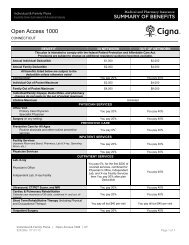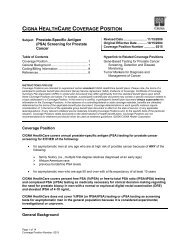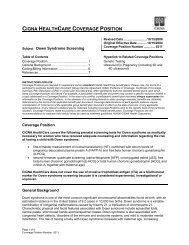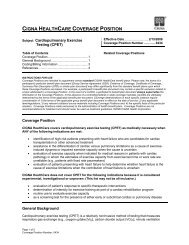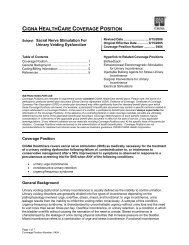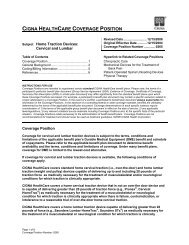Magnetic Resonance Imaging (MRI), Low-Field
Magnetic Resonance Imaging (MRI), Low-Field
Magnetic Resonance Imaging (MRI), Low-Field
You also want an ePaper? Increase the reach of your titles
YUMPU automatically turns print PDFs into web optimized ePapers that Google loves.
Magee et al. (2003) used a 0.2 T open-design MR scanner for detection of supraspinatus tendon tearsand labral tears in 40 patients, compared with 1.5 T and arthroscopy. The authors stated that high-fieldstrengthimages altered reviewers' interpretations of low-field-strength scans for nine of 40 patients. Infour patients, full-thickness supraspinatus tendon tears could be diagnosed definitively on the high-fieldstrengthunit but not on the open unit. Three labral tears and two superior labral anteroposterior lesionscould be depicted definitively on the high-field-strength unit but not on the open unit. All tears wereconfirmed at arthroscopy. The authors concluded that high-field-strength <strong>MRI</strong> units provide better spatialand contrast resolution and allow more accurate interpretations than low-field-strength units; thesefindings may affect clinical treatment.Shellock et al. (2001) used a 0.2 T extremity-dedicated MR scanner to detect lesions of the rotator cuffand glenoid labrum in 47 patients, compared to the surgical findings. For the rotator cuff tears, thesensitivity, specificity, positive predictive value, and negative predictive value were 89%, 100%, 100%,and 90% (three false negatives), respectively. For the labral lesions, the sensitivity, specificity, positivepredictive value, and negative predictive value were 89%, 95%, 80%, and 97% ( two false positives, onefalse negative), respectively. The findings indicated that there was good agreement comparing the lowfieldMR results to the surgical findings for determination of lesions of the rotator cuff and glenoid labrum.This study did not evaluate conventional <strong>MRI</strong> compared to low-field or surgical findings.Loew et al. (2000) used a 0.2 T open-design MR scanner to compare the image quality, sensitivity,specificity, and diagnostic accuracy of low-field MR with 1.5 T MR after arthrography of the shoulder.Thirty-eight patients either with suspected chronic instability (n = 12) or rotator cuff abnormalities (n = 26)were examined. Intra-articular injection of diluted Gd-DTPA was followed in randomized order either firstby imaging on an open 0.2 T system or on a 1.5 T system. The image material was evaluatedindependently by two radiologists in a blinded fashion with respect to overall image quality and thedetection of rotator cuff as well as capsular and labral abnormalities. Surgical correlation was available in27 (71%) of 38 patients. For both systems, sensitivity and specificity for rotator cuff tears were 100%each, and for labrum pathologies, these values were 100 and 93%, respectively. The authors concludedthat low-field MR compares favorably to high-field MR in the detection of major abnormalities of theglenohumeral joint, at least when MR arthrography is used. Disadvantages are the duration of theexamination and thus the risk of reduced image quality caused by motion artifacts. It should be noted thatthere was an intentional use of different sequences at each MR unit. Also, the small number of patients(27) evaluated limits the power of the statistical results.Tung et al. (2000) used a 0.2 T open-design MR scanner to diagnose a glenoid superior labralanteroposterior (SLAP) tears compared to 1.5 T MR. Forty-one patients with SLAP tears and 26symptomatic patients with normal superior labra were retrospectively evaluated. Both groups of patientshad either high-field (n = 46) or low-field (n = 21) <strong>MRI</strong> and arthroscopy. For the diagnosis of SLAP tear,the sensitivity of high-field <strong>MRI</strong> was 90%, specificity was 63%, and accuracy was 80%. The sensitivity oflow-field <strong>MRI</strong> was 64%, specificity was 70%, and accuracy was 67%. Authors stated that the performancecharacteristics of high-field <strong>MRI</strong> are superior to those of low-field <strong>MRI</strong> for the diagnosis of a superior labraltear. Again, the small number of patients evaluated limits the power of the statistical results.Merl et al. (1999) prospectively evaluated the diagnostic quality of an open design 0.2 T MR scannercompared with high-field MR scanners measured by the applicable gold standard. Over a period of 3months, 401 patients with suspected renal tumors (n=78), diseases of the capsulolabral complex and therotator cuff of the shoulder joint (n=122), diseases of the spinal canal (n=105) and of the brain with focalneurological deficit (n=96) were prospectively evaluated in four participating centers. They all underwentclinical evaluation, low-field and high-field <strong>MRI</strong> and surgical or follow-up confirmation of diagnosis.Clinical, histopathologic, high-field and low-field <strong>MRI</strong> diagnoses were recorded in standardizedquestionnaires that were centrally evaluated. Statistical evaluation comprised two parts: receiveroperating characteristic (ROC) analysis assessed accuracy of <strong>MRI</strong> and clinical diagnoses; furthermore,rates of concordance of high- and low-field <strong>MRI</strong> diagnosis were calculated. Researchers did not compareimages and record differences between the different systems, but both class of units were measuredagainst the clinical gold standard and their diagnostic accuracy determined. Researchers found nostatistically relevant difference in high-field <strong>MRI</strong> diagnosis compared to low-field <strong>MRI</strong> diagnostic accuracymeasured by clinical or surgical gold standard in three of the four regions examined; in cerebralexaminations there was a small yet significant advantage for the high-field systems. The authorsPage 6 of 17Coverage Position Number: 0444





